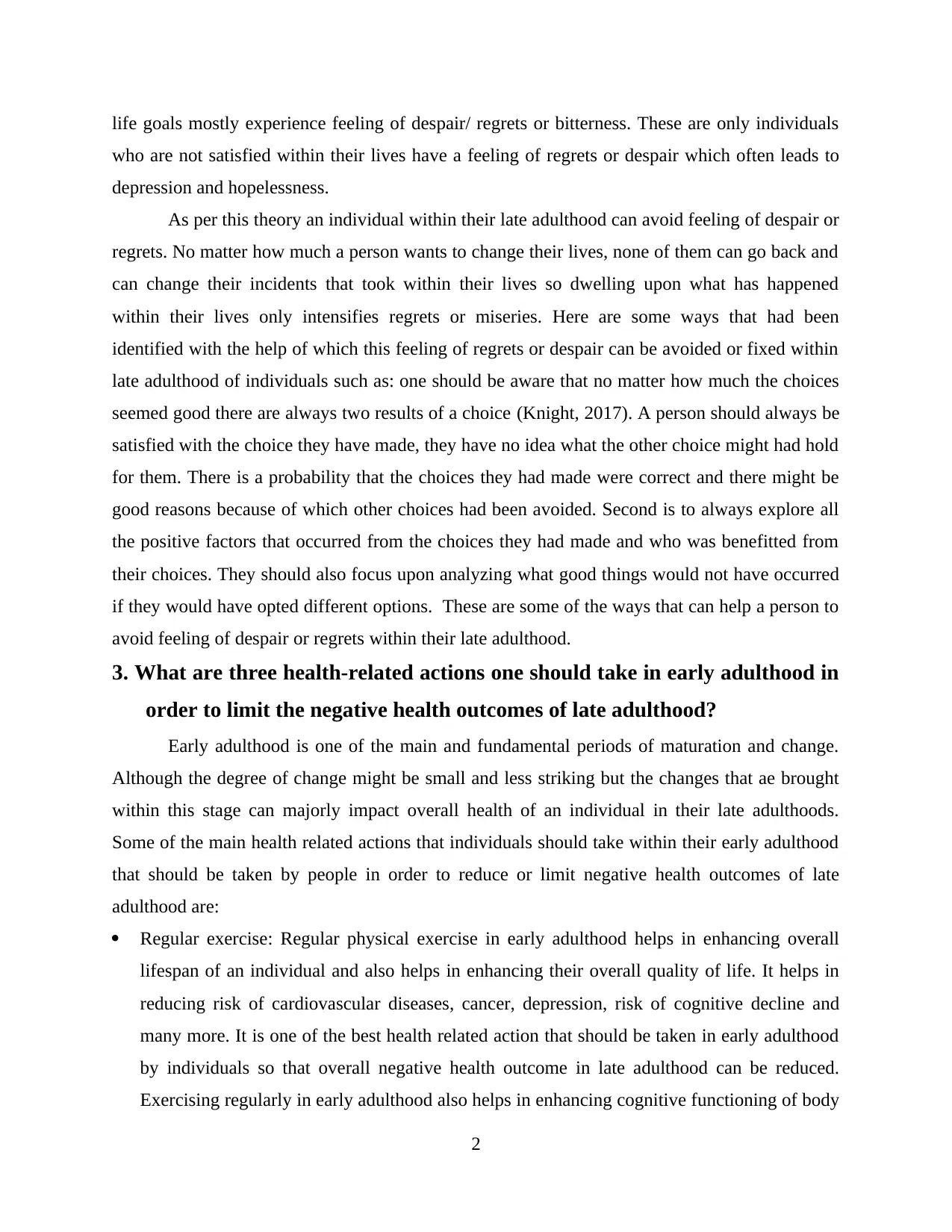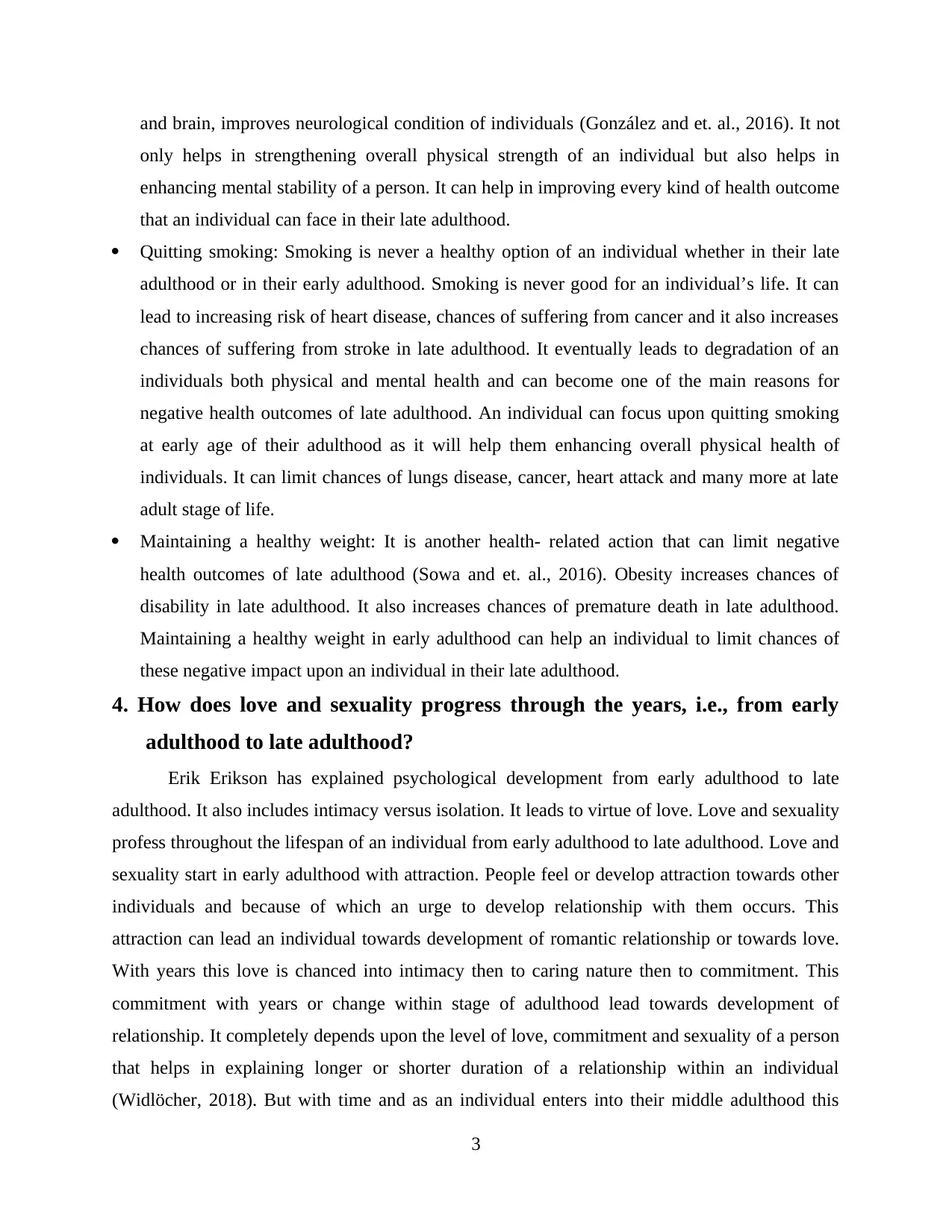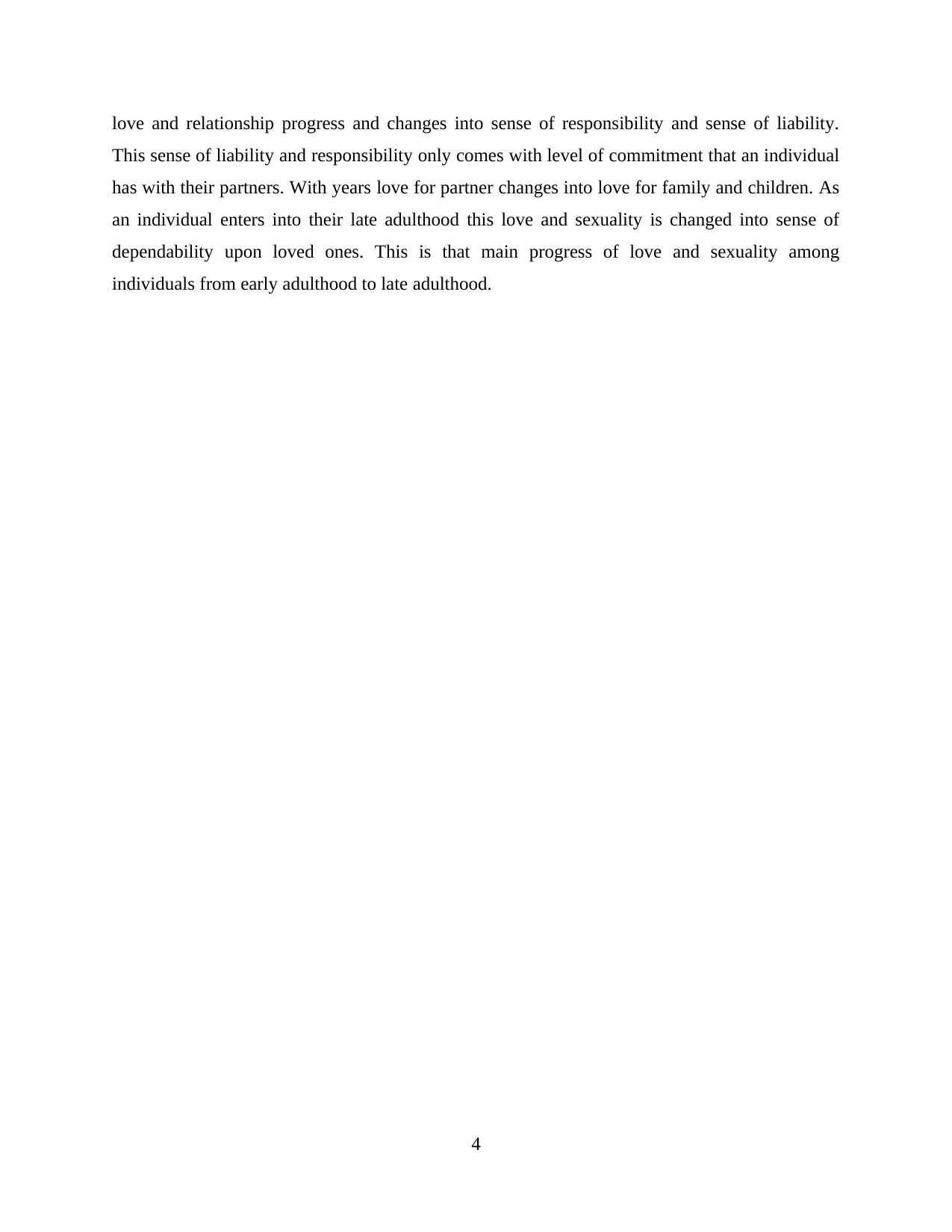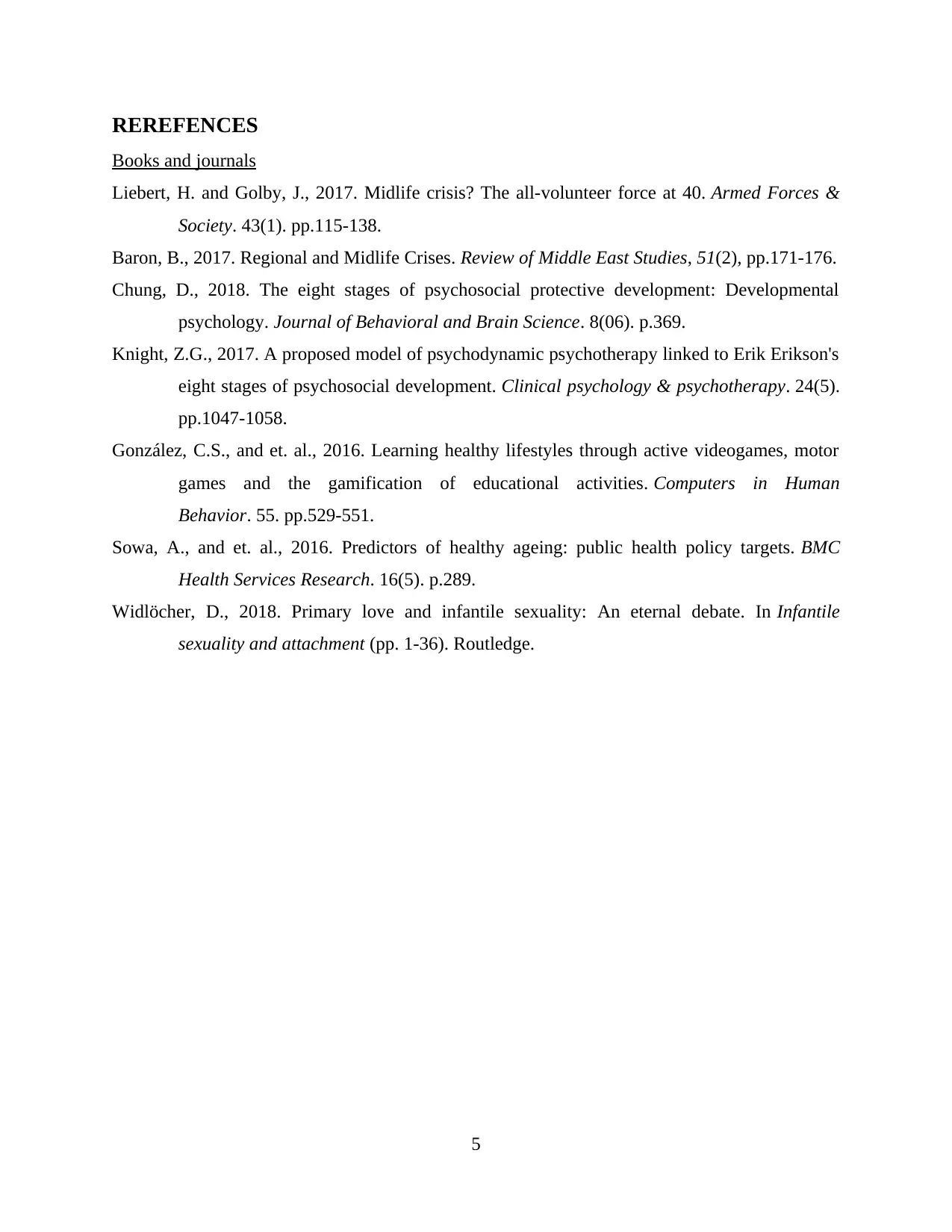Midlife Crises: Real or Construct?
VerifiedAdded on 2023/01/10
|7
|1877
|82
AI Summary
This article delves into the concept of midlife crises, discussing its reality and who is more likely to experience it. It explores the various factors and symptoms associated with midlife crises, shedding light on this transitional phase of self-confidence and identity.
Contribute Materials
Your contribution can guide someone’s learning journey. Share your
documents today.

PSYCHOLOGY 220
PROJECT
PROJECT
Secure Best Marks with AI Grader
Need help grading? Try our AI Grader for instant feedback on your assignments.

TABLE OF CONTENTS
1. Are midlife crises real? Who is more likely to experience a midlife crisis?...............................1
2. According to Erik Ericson, how can one avoid the despair/regret fixation of late adulthood?...1
3. What are three health-related actions one should take in early adulthood in order to limit the
negative health outcomes of late adulthood?...................................................................................2
4. How does love and sexuality progress through the years, i.e., from early adulthood to late
adulthood?........................................................................................................................................3
REREFENCES................................................................................................................................5
1. Are midlife crises real? Who is more likely to experience a midlife crisis?...............................1
2. According to Erik Ericson, how can one avoid the despair/regret fixation of late adulthood?...1
3. What are three health-related actions one should take in early adulthood in order to limit the
negative health outcomes of late adulthood?...................................................................................2
4. How does love and sexuality progress through the years, i.e., from early adulthood to late
adulthood?........................................................................................................................................3
REREFENCES................................................................................................................................5

1. Are midlife crises real? Who is more likely to experience a midlife crisis?
Midlife transition can be defined as a kind of transition of self- confidence and identity
that can occur within individuals typically when they are 45 years to 55 years old. It is a stage in
which people feel youthful again and they struggle to come up with a fact that their lives are half
over. Yes, midlife crises are real, but not everyone experience such midlife crises. There are
various studies that clearly explains that mid life crises are not a major issue for most of the
people in the world. Many people think that midlife crises are a kind of social construct that lead
some people to experience breakdown. Midlife crises can be faced by both men and men who are
of age of 45 to 64 years (Liebert and Golby, 2017). Within men midlife crises last maximum 3 to
10 years but in women it last 2 to 5 years. There are many reasons because of which men and
women can suffer from these midlife crises. Some of the most common factors are: aging, aging
with numerous changes in body, problems, work or career regrets and many more. But majority
of times midlife crises are experienced by people only because of major events within their lives
such as major loss of someone close, divorce, job loss and many other reasons. According to a
survey that was conducted on national level it was identified that approximately 26 percent of
participants of the survey reported having midlife crises (Baron, 2017). People who suffer from
these crises cannot be identified or diagnosed easily. There are many symptoms that slowly
slowly indicate that, that particular person is suffering from midlife crises. Some of the most
common symptoms of these midlife crises are: change in sleeping habits, neglection of personal
hygiene, weight gain or loss, withdrawal from usual relationship, change in mood like increased
anger, irritability, anxiety or sadness.
2. According to Erik Ericson, how can one avoid the despair/regret fixation of
late adulthood?
Erik Ericson has explained some stages of psychological development. He has helped in
explaining personality development in a predetermined order with the help of eight stages of
psychological development from infancy to adulthood. Last adulthood is the last stage of
psychological development of Erik Ericson. Basic virtue of last stage of Erik Ericson
psychological development is wisdom in which Ego Integrity vs Despair is focused upon
(Chung, 2018). Ego Integrity vs. Despair is the last stage which begins at late adulthood of age
group of 65 years and above approximately. At this stage of late adulthood life is unproductive,
feeling of guilt and of many more. Individuals in their late adulthood who do not achieve their
1
Midlife transition can be defined as a kind of transition of self- confidence and identity
that can occur within individuals typically when they are 45 years to 55 years old. It is a stage in
which people feel youthful again and they struggle to come up with a fact that their lives are half
over. Yes, midlife crises are real, but not everyone experience such midlife crises. There are
various studies that clearly explains that mid life crises are not a major issue for most of the
people in the world. Many people think that midlife crises are a kind of social construct that lead
some people to experience breakdown. Midlife crises can be faced by both men and men who are
of age of 45 to 64 years (Liebert and Golby, 2017). Within men midlife crises last maximum 3 to
10 years but in women it last 2 to 5 years. There are many reasons because of which men and
women can suffer from these midlife crises. Some of the most common factors are: aging, aging
with numerous changes in body, problems, work or career regrets and many more. But majority
of times midlife crises are experienced by people only because of major events within their lives
such as major loss of someone close, divorce, job loss and many other reasons. According to a
survey that was conducted on national level it was identified that approximately 26 percent of
participants of the survey reported having midlife crises (Baron, 2017). People who suffer from
these crises cannot be identified or diagnosed easily. There are many symptoms that slowly
slowly indicate that, that particular person is suffering from midlife crises. Some of the most
common symptoms of these midlife crises are: change in sleeping habits, neglection of personal
hygiene, weight gain or loss, withdrawal from usual relationship, change in mood like increased
anger, irritability, anxiety or sadness.
2. According to Erik Ericson, how can one avoid the despair/regret fixation of
late adulthood?
Erik Ericson has explained some stages of psychological development. He has helped in
explaining personality development in a predetermined order with the help of eight stages of
psychological development from infancy to adulthood. Last adulthood is the last stage of
psychological development of Erik Ericson. Basic virtue of last stage of Erik Ericson
psychological development is wisdom in which Ego Integrity vs Despair is focused upon
(Chung, 2018). Ego Integrity vs. Despair is the last stage which begins at late adulthood of age
group of 65 years and above approximately. At this stage of late adulthood life is unproductive,
feeling of guilt and of many more. Individuals in their late adulthood who do not achieve their
1

life goals mostly experience feeling of despair/ regrets or bitterness. These are only individuals
who are not satisfied within their lives have a feeling of regrets or despair which often leads to
depression and hopelessness.
As per this theory an individual within their late adulthood can avoid feeling of despair or
regrets. No matter how much a person wants to change their lives, none of them can go back and
can change their incidents that took within their lives so dwelling upon what has happened
within their lives only intensifies regrets or miseries. Here are some ways that had been
identified with the help of which this feeling of regrets or despair can be avoided or fixed within
late adulthood of individuals such as: one should be aware that no matter how much the choices
seemed good there are always two results of a choice (Knight, 2017). A person should always be
satisfied with the choice they have made, they have no idea what the other choice might had hold
for them. There is a probability that the choices they had made were correct and there might be
good reasons because of which other choices had been avoided. Second is to always explore all
the positive factors that occurred from the choices they had made and who was benefitted from
their choices. They should also focus upon analyzing what good things would not have occurred
if they would have opted different options. These are some of the ways that can help a person to
avoid feeling of despair or regrets within their late adulthood.
3. What are three health-related actions one should take in early adulthood in
order to limit the negative health outcomes of late adulthood?
Early adulthood is one of the main and fundamental periods of maturation and change.
Although the degree of change might be small and less striking but the changes that ae brought
within this stage can majorly impact overall health of an individual in their late adulthoods.
Some of the main health related actions that individuals should take within their early adulthood
that should be taken by people in order to reduce or limit negative health outcomes of late
adulthood are:
Regular exercise: Regular physical exercise in early adulthood helps in enhancing overall
lifespan of an individual and also helps in enhancing their overall quality of life. It helps in
reducing risk of cardiovascular diseases, cancer, depression, risk of cognitive decline and
many more. It is one of the best health related action that should be taken in early adulthood
by individuals so that overall negative health outcome in late adulthood can be reduced.
Exercising regularly in early adulthood also helps in enhancing cognitive functioning of body
2
who are not satisfied within their lives have a feeling of regrets or despair which often leads to
depression and hopelessness.
As per this theory an individual within their late adulthood can avoid feeling of despair or
regrets. No matter how much a person wants to change their lives, none of them can go back and
can change their incidents that took within their lives so dwelling upon what has happened
within their lives only intensifies regrets or miseries. Here are some ways that had been
identified with the help of which this feeling of regrets or despair can be avoided or fixed within
late adulthood of individuals such as: one should be aware that no matter how much the choices
seemed good there are always two results of a choice (Knight, 2017). A person should always be
satisfied with the choice they have made, they have no idea what the other choice might had hold
for them. There is a probability that the choices they had made were correct and there might be
good reasons because of which other choices had been avoided. Second is to always explore all
the positive factors that occurred from the choices they had made and who was benefitted from
their choices. They should also focus upon analyzing what good things would not have occurred
if they would have opted different options. These are some of the ways that can help a person to
avoid feeling of despair or regrets within their late adulthood.
3. What are three health-related actions one should take in early adulthood in
order to limit the negative health outcomes of late adulthood?
Early adulthood is one of the main and fundamental periods of maturation and change.
Although the degree of change might be small and less striking but the changes that ae brought
within this stage can majorly impact overall health of an individual in their late adulthoods.
Some of the main health related actions that individuals should take within their early adulthood
that should be taken by people in order to reduce or limit negative health outcomes of late
adulthood are:
Regular exercise: Regular physical exercise in early adulthood helps in enhancing overall
lifespan of an individual and also helps in enhancing their overall quality of life. It helps in
reducing risk of cardiovascular diseases, cancer, depression, risk of cognitive decline and
many more. It is one of the best health related action that should be taken in early adulthood
by individuals so that overall negative health outcome in late adulthood can be reduced.
Exercising regularly in early adulthood also helps in enhancing cognitive functioning of body
2
Secure Best Marks with AI Grader
Need help grading? Try our AI Grader for instant feedback on your assignments.

and brain, improves neurological condition of individuals (González and et. al., 2016). It not
only helps in strengthening overall physical strength of an individual but also helps in
enhancing mental stability of a person. It can help in improving every kind of health outcome
that an individual can face in their late adulthood.
Quitting smoking: Smoking is never a healthy option of an individual whether in their late
adulthood or in their early adulthood. Smoking is never good for an individual’s life. It can
lead to increasing risk of heart disease, chances of suffering from cancer and it also increases
chances of suffering from stroke in late adulthood. It eventually leads to degradation of an
individuals both physical and mental health and can become one of the main reasons for
negative health outcomes of late adulthood. An individual can focus upon quitting smoking
at early age of their adulthood as it will help them enhancing overall physical health of
individuals. It can limit chances of lungs disease, cancer, heart attack and many more at late
adult stage of life.
Maintaining a healthy weight: It is another health- related action that can limit negative
health outcomes of late adulthood (Sowa and et. al., 2016). Obesity increases chances of
disability in late adulthood. It also increases chances of premature death in late adulthood.
Maintaining a healthy weight in early adulthood can help an individual to limit chances of
these negative impact upon an individual in their late adulthood.
4. How does love and sexuality progress through the years, i.e., from early
adulthood to late adulthood?
Erik Erikson has explained psychological development from early adulthood to late
adulthood. It also includes intimacy versus isolation. It leads to virtue of love. Love and sexuality
profess throughout the lifespan of an individual from early adulthood to late adulthood. Love and
sexuality start in early adulthood with attraction. People feel or develop attraction towards other
individuals and because of which an urge to develop relationship with them occurs. This
attraction can lead an individual towards development of romantic relationship or towards love.
With years this love is chanced into intimacy then to caring nature then to commitment. This
commitment with years or change within stage of adulthood lead towards development of
relationship. It completely depends upon the level of love, commitment and sexuality of a person
that helps in explaining longer or shorter duration of a relationship within an individual
(Widlöcher, 2018). But with time and as an individual enters into their middle adulthood this
3
only helps in strengthening overall physical strength of an individual but also helps in
enhancing mental stability of a person. It can help in improving every kind of health outcome
that an individual can face in their late adulthood.
Quitting smoking: Smoking is never a healthy option of an individual whether in their late
adulthood or in their early adulthood. Smoking is never good for an individual’s life. It can
lead to increasing risk of heart disease, chances of suffering from cancer and it also increases
chances of suffering from stroke in late adulthood. It eventually leads to degradation of an
individuals both physical and mental health and can become one of the main reasons for
negative health outcomes of late adulthood. An individual can focus upon quitting smoking
at early age of their adulthood as it will help them enhancing overall physical health of
individuals. It can limit chances of lungs disease, cancer, heart attack and many more at late
adult stage of life.
Maintaining a healthy weight: It is another health- related action that can limit negative
health outcomes of late adulthood (Sowa and et. al., 2016). Obesity increases chances of
disability in late adulthood. It also increases chances of premature death in late adulthood.
Maintaining a healthy weight in early adulthood can help an individual to limit chances of
these negative impact upon an individual in their late adulthood.
4. How does love and sexuality progress through the years, i.e., from early
adulthood to late adulthood?
Erik Erikson has explained psychological development from early adulthood to late
adulthood. It also includes intimacy versus isolation. It leads to virtue of love. Love and sexuality
profess throughout the lifespan of an individual from early adulthood to late adulthood. Love and
sexuality start in early adulthood with attraction. People feel or develop attraction towards other
individuals and because of which an urge to develop relationship with them occurs. This
attraction can lead an individual towards development of romantic relationship or towards love.
With years this love is chanced into intimacy then to caring nature then to commitment. This
commitment with years or change within stage of adulthood lead towards development of
relationship. It completely depends upon the level of love, commitment and sexuality of a person
that helps in explaining longer or shorter duration of a relationship within an individual
(Widlöcher, 2018). But with time and as an individual enters into their middle adulthood this
3

love and relationship progress and changes into sense of responsibility and sense of liability.
This sense of liability and responsibility only comes with level of commitment that an individual
has with their partners. With years love for partner changes into love for family and children. As
an individual enters into their late adulthood this love and sexuality is changed into sense of
dependability upon loved ones. This is that main progress of love and sexuality among
individuals from early adulthood to late adulthood.
4
This sense of liability and responsibility only comes with level of commitment that an individual
has with their partners. With years love for partner changes into love for family and children. As
an individual enters into their late adulthood this love and sexuality is changed into sense of
dependability upon loved ones. This is that main progress of love and sexuality among
individuals from early adulthood to late adulthood.
4

REREFENCES
Books and journals
Liebert, H. and Golby, J., 2017. Midlife crisis? The all-volunteer force at 40. Armed Forces &
Society. 43(1). pp.115-138.
Baron, B., 2017. Regional and Midlife Crises. Review of Middle East Studies, 51(2), pp.171-176.
Chung, D., 2018. The eight stages of psychosocial protective development: Developmental
psychology. Journal of Behavioral and Brain Science. 8(06). p.369.
Knight, Z.G., 2017. A proposed model of psychodynamic psychotherapy linked to Erik Erikson's
eight stages of psychosocial development. Clinical psychology & psychotherapy. 24(5).
pp.1047-1058.
González, C.S., and et. al., 2016. Learning healthy lifestyles through active videogames, motor
games and the gamification of educational activities. Computers in Human
Behavior. 55. pp.529-551.
Sowa, A., and et. al., 2016. Predictors of healthy ageing: public health policy targets. BMC
Health Services Research. 16(5). p.289.
Widlöcher, D., 2018. Primary love and infantile sexuality: An eternal debate. In Infantile
sexuality and attachment (pp. 1-36). Routledge.
5
Books and journals
Liebert, H. and Golby, J., 2017. Midlife crisis? The all-volunteer force at 40. Armed Forces &
Society. 43(1). pp.115-138.
Baron, B., 2017. Regional and Midlife Crises. Review of Middle East Studies, 51(2), pp.171-176.
Chung, D., 2018. The eight stages of psychosocial protective development: Developmental
psychology. Journal of Behavioral and Brain Science. 8(06). p.369.
Knight, Z.G., 2017. A proposed model of psychodynamic psychotherapy linked to Erik Erikson's
eight stages of psychosocial development. Clinical psychology & psychotherapy. 24(5).
pp.1047-1058.
González, C.S., and et. al., 2016. Learning healthy lifestyles through active videogames, motor
games and the gamification of educational activities. Computers in Human
Behavior. 55. pp.529-551.
Sowa, A., and et. al., 2016. Predictors of healthy ageing: public health policy targets. BMC
Health Services Research. 16(5). p.289.
Widlöcher, D., 2018. Primary love and infantile sexuality: An eternal debate. In Infantile
sexuality and attachment (pp. 1-36). Routledge.
5
1 out of 7
Your All-in-One AI-Powered Toolkit for Academic Success.
+13062052269
info@desklib.com
Available 24*7 on WhatsApp / Email
![[object Object]](/_next/static/media/star-bottom.7253800d.svg)
Unlock your academic potential
© 2024 | Zucol Services PVT LTD | All rights reserved.
